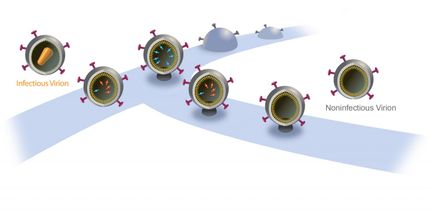Scripps Research scientists find two compounds that lay the foundation for a new class of AIDS drug
Novel therapies could improve potency of existing AIDS treatments, help to combat drug-resistant virus strains
Advertisement
A team of scientists at The Scripps Research Institute has identified two compounds that act on novel binding sites for an enzyme used by the human immunodeficiency virus (HIV), the virus that causes AIDS. The discovery lays the foundation for the development of a new class of anti-HIV drugs to enhance existing therapies, treat drug-resistant strains of the disease, and slow the evolution of drug resistance in the virus. The research will appear in chemical biology & drug design.
The anti-HIV compounds identified in the new study bind to HIV protease — an enzyme essential to the lifecycle of the virus. Drugs that block this viral enzyme are called "protease inhibitors" and currently make up an important part of the successful AIDS drug cocktail known as highly active anti-retroviral therapy (HAART).
Compared with the nine U.S. Food and Drug Administration (FDA)-approved drugs that target HIV protease, however, the two new compounds, which are small chemical units or "fragments," bind with two novel parts of the molecule. This could make future drugs incorporating the fragments' novel structural elements a useful complement to existing treatments.
"The study's results open the door to a whole new approach to drug design against HIV protease," said Scripps Research Associate Professor C. David Stout, senior author of the study. "The fragments bound at not one, but two, different crevices in protease outside the active site. This is an important proof-of-concept that the protease molecule has two non-active site binding pockets ('allosteric sites which can now be exploited as a powerful new strategy to combat drug-resistance in HIV."
Research Associate Alex L. Perryman, first author of the paper and member of Professor Arthur Olson's laboratory at Scripps Research, added, "The experiments validate my hypothesis developed from computational modeling that HIV protease has pockets on its surface besides the active site that can bind drugs. Drugs developed to target these sites could be used to make current FDA-approved active site inhibitors more potent and to restore their effectiveness against drug-resistant superbugs. The whole strategy of targeting non-active sites may also prove useful against other diseases, especially when there are mutations that cause drug resistance."
















































